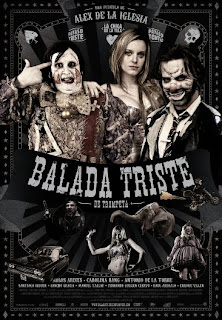Entry #8 of the
Euro 2012 Book & Film Spotlight looks at the two films from England.
Shame (2011, Steve McQueen)
Brandon (Michael Fassbender) has a well playing job in New York City but his job bores him. As a result, he freely channels his energy into sex, an activity that occupies both his disposal income and time. Brandon is not afraid to satisfy himself when needed and on other occasions he pays to have a rip roaring good time. All the sex he has is cold and meaningless and only meant to quench his thirst. It is the real relationships that he struggles with, such as the one with his sister (Carey Mulligan) or Marianne (Nicole Beharie).

Brandon cannot perform with Marianne but as soon as she leaves, he is able to freely release himself into a prostitute. Brandon cannot get it up when love is involved but sex is easier with paid prostitutes as that eliminates any barrier of shame.
Brandon’s addiction to sex is slowly ruining his life but he does not realize that until his sister arrives and he has to look after her. As expected, he eventually hits rock bottom, is mentally defeated and loses his icy cool confidence.

Two sequences which bookend the film perfectly illustrate the change in Brandon’s personality and confidence.
At the start of the film, he is sitting in a train when he eyes a woman.


She sees him and shows interest. A seduction takes place, the woman is aroused and shifts her legs slightly.

Brandon is cool, confident and completely in control.

The woman breaks out of her seductive trance and realizes what she is doing. She is ashamed of her actions, even though the action only took place mentally.

She hastens her departure and the camera shows us the reason for her guilt: she is married.

But that does not stop Brandon. He stands close to her. She can sense his presence and once again she undergoes a sexual roller coaster of emotions.


She runs away when the train stops. Brandon follows her but loses her in the crowd.
After Brandon hits rock bottom, he eyes the woman again.

She looks ravishing and inviting.

This time around she tempts him. She looks to her left indicating her stop is about to arrive and stands close to him. Brandon looks at her ring and then at her. He looks disgusted. He is trying to clean his life up and here she is tempting him towards the garden of Eden. Her red lipstick represents that juicy red apple meant to draw him down the path of sin.
What Brandon chooses is left up to the viewer’s imagination but no matter what choice he makes, he won’t be happy.
Tinker Tailor Soldier Spy (2011, Tomas Alfredson)

The life of a spy is packed with
information and misinformation. Some misinformation is required to muddy the waters in order to get a reaction from the opposing side, which will result in the next chess move. However, it often happens that misinformation can lead to a "blowback" and that leads to a larger mess. Untangling such a mess means each side has to thoroughly go through their hierarchy to weed out the traitors.
Tinker Tailor Soldier Spy is about such a cleansing operation where the British have to find out who the mole is on their side and in doing so they enlist the help of George Smiley (Gary Oldman). The film moves back and forth in time, further casting a shadow on proceedings. Two viewings of the film are essential to grab a handle on events as a first viewing will help determine the identity of the mole while a second viewing will help piece the full picture of events. Or one could read
David Bordwell’s excellent review which is an essential reading guide for the film.
The kind of spies and the work they do in
Tinker Tailor Soldier Spy are aptly described by
The Spy Who Came in from the Cold, another film adaptation of John le Carré’s novel of the same name.
What the hell do you think spies are? Moral philosophers measuring everything they do against the word of God or Karl Marx? They're not! They're just a bunch of seedy, squalid bastards like me: little men, drunkards, queers, hen-pecked husbands, civil servants playing cowboys and Indians to brighten their rotten little lives. Do you think they sit like monks in a cell, balancing right against wrong?
............
Our work, as I understand it.. is based on a single assumption that the West is never going to be the aggressor. Thus..we do disagreeable things..but we’re defensive. Our policies are peaceful..but our methods can’t afford to be less ruthless than those of the opposition.
You know, I’d say, uh..since the war, our methods - our techniques, that is - and those of the Communists, have become very much the same. Yes. I mean, occasionally...we have to do wicked things. Very wicked things indeed. But, uh, you can’t be less wicked..than your enemies simply because your government’s policy is benevolent.
England-Sweden, again
Tinker Tailor Soldier Spy is directed by the Swede Tomas Alfredson. As a result, the film is an appropriate choice for the Euro spotlight as England and Sweden are once again drawn in the same group in a major international soccer tournament. If history is any guide, the game between the two teams will end in a 1-1 draw.












































